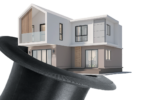Predicting the next hip neighborhood can translate into big business.
By Donna Shryer
Getting listings and sales in the next hip neighborhood doesn’t take a crystal ball, but it does take an ability to read the smoke signals before an area gets really hot. REALTORS® savvy enough to see these early signs can get in on the ground floor, position themselves for soon-to-come rising property prices and celebrate a swell of transaction numbers.
Sign Language
Here are several of the top signs that typically foretell a neighborhood’s rebirth.
Demographic Fellowship. Predicting neighborhood turnarounds, says Sandra Nickel, CRS, Broker/Owner of Sandra Nickel Hat Team, REALTORS® in Montgomery, Alabama, begins by watching where certain populations cluster. These target populations represent an eclectic collection of professions, but generally encompass entrepreneurs, millennials, artists and well-educated individuals, which often include the underemployed. The primary common denominator, Nickel emphasizes, is that these folks are not affluent and cannot afford exclusive, gentrified areas—so they build new affordable communities. The result, Nickel adds, is not a luxury market, but rather what she calls a “wonderfully hip” multicultural neighborhood that draws the indie art and music scene, restaurateurs and other cultural touchstones that require space at reasonable prices.
What’s in a Word?
The definition of “gentrification” is changing as quickly as America’s neighborhoods. For example, if you search online for “top hip neighborhoods” vs. “top gentrified neighborhoods,” you’ll likely get two distinct lists. So it’s a good idea to consider your buyer and choose your words carefully. “Gentrified” says affluent and upscale. “Hip,” or sometimes “hot,” says affordable neighborhood with an urban feel, good restaurants, a high walkability score and a multicultural, eclectic community.
“As these groups build a community, you’ll see one block transformed, then the next, and eventually the entire area catches on fire. Rent and property prices will increase, but overall, costs remain affordable,” Nickel says.
To monitor a community’s turnaround progress, check out local retailers, art galleries and music venues. You’re looking for creative entrepreneurs investing in their own community and also sparking interest from nearby neighborhoods.
Halo Effect. In their book, Zillow Talk: The New Rules of Real Estate, co-authors Spencer Rascoff and Stan Humphries, Zillow Group CEO and chief analytics officer respectively, explain how a neighborhood’s property values tend to improve when in the “halo” of an upmarket area.
To predict the next hip community, look to the outer rings of an exclusive neighborhood’s halo. For example, within the nucleus of Boston’s halo, there’s Beacon Hill and Back Bay. Go a little further out and there’s the gentrified South End and Downtown areas. Pan out further and there’s East Boston, for which Zillow forecasts a 4.9 percent growth in home values by 2017.
To push the halo, Nickel suggests focusing on areas with “good bones”—which means neighborhoods with older, architecturally interesting properties. “Property owners may not have been able to afford maintenance or renovation. So there’s work to be done, but the investment should be well worth it,” Nickel says.
Go Social. At the 25th International World Wide Web Conference in Montreal, researchers from the University of Cambridge reported that social media apps may be the best way to predict up-and-coming neighborhoods. In 2010, researchers used Foursquare and Twitter data to define neighborhoods where Londoners and their friends often “checked in.” Five years later, researchers looked at 2010’s most popular neighborhoods, and they found that these communities were either on the road to or fully gentrified by 2015.
Research highly reviewed restaurants, music venues, etc., on Yelp and places with a lot of check-ins on Foursquare. Your connections— feeds on Twitter and Facebook—may point to popular places as well. These answers could point to the next hip neighborhood.
To Market You Go
When Nickel spots a neighborhood leaning toward gentrification, she has two strategies for marketing herself as the REALTOR® who rules the area. Her first tactic is a direct mail newsletter that creates a refreshed neighborhood identity. “My goal is to let everyone know that they live and work in a great place. I interview residents and business owners, and focus on neighborhood news.”
Nickel may also include a comparative market analysis of the community, which shows that she’s aware of the neighborhood’s sales activity.
A second marketing tactic is to join the neighborhood association. “If there’s no association, I establish one,” Nickel stresses. “Most municipalities have a department of neighborhoods or planning that will support you.”
Nickel enjoys farming hip neighborhoods and becoming the agent of choice in these communities, although there’s a caveat. “It’s not a market for anyone who wants to get rich quick. There’s often a long building process before a neighborhood officially hits hip status. But if you care as much about making a difference as making a living, these neighborhoods are your ideal market.”
The Cost of Being Hip
REALTORS® looking to work with buyers in up-and-coming neighborhoods need to know about financing niches, explains Sandra Nickel, CRS, broker/owner of Sandra Nickel Hat Team, REALTORS® in Montgomery, Alabama. “Sometimes these neighborhoods make lenders nervous,” Nickel says. “You have to know which lenders have Community Reinvestment Act funds or are open to creating a similar program.”
Nickel also suggests becoming familiar with programs like FHA 203(k), municipality-sponsored incentives and tax credits. “Properties in areas that are beginning to turn around are often in sad condition. And the young people most attracted to these neighborhoods don’t have the money for major rehab projects,” she says. “So you have to get these buyers in with a minimum down payment and then help them find ways to finance improvements.”
Learn more about home price fluctuation in your area and how to look for “halo effect” zip codes.








